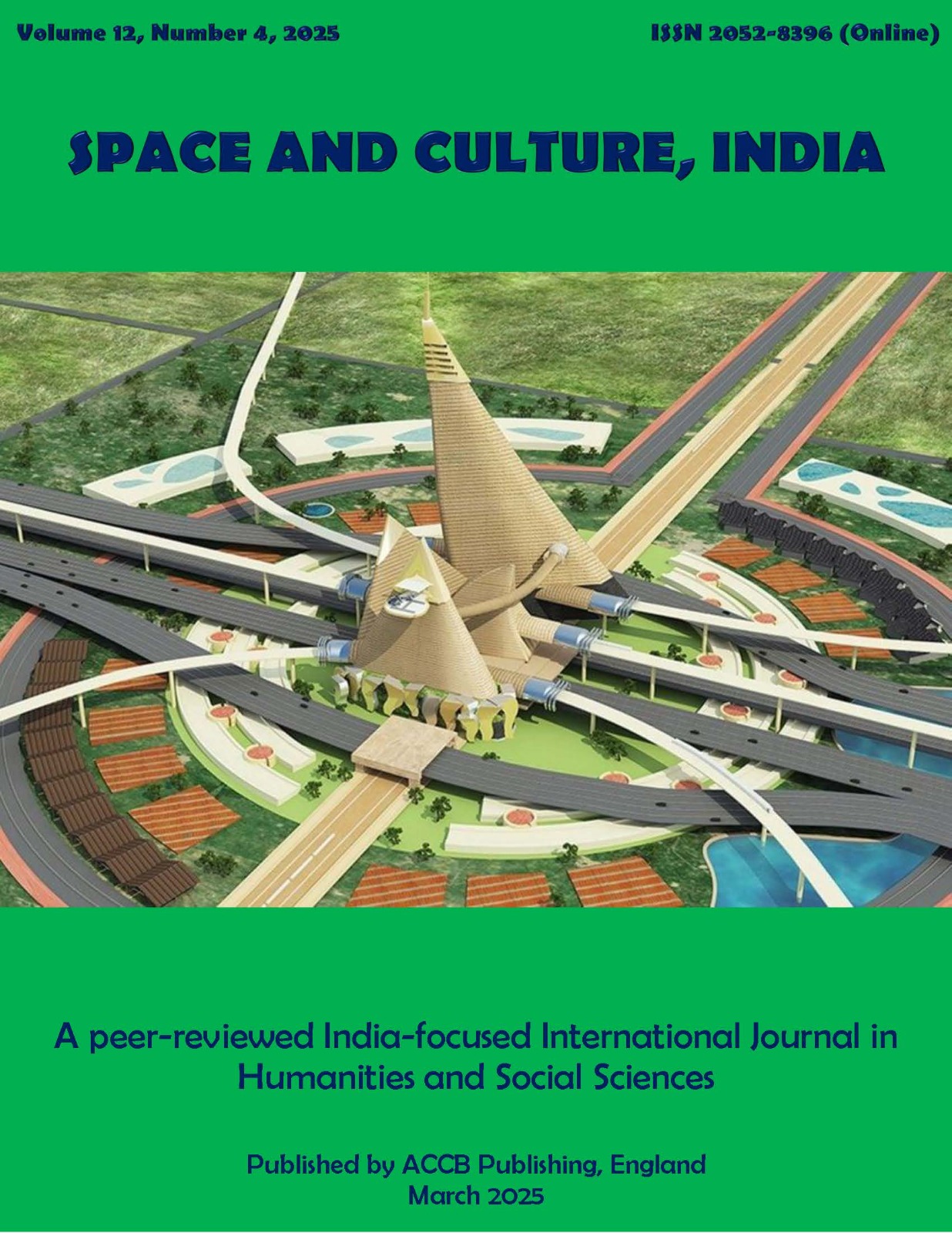Reinterpreting the Play: Women’s Cultural Performance as a Subversive Site

Abstract
This study investigates women’s performances, such as Khela-Tamasha (play-act), Nakkal (enactment/imitation), and Kajari folksongs, as potent tools for questioning the gender stereotypes and hegemonic gender ideals which subordinate women. To achieve the objectives of this study, ethnographic data were collected in 2022-2023 across Mirzapur, located in the state of Uttar Pradesh, India. Drawing on Judith Butler’s gender performativity theory and Antonio Gramsci’s theory of counter-hegemony, this study argues that rural women’s traditional play-acts and enactments, characterised by cross-dressing, theatricality, and bold speech, challenge their oppression. Through their performative expressions, these women harness the power of cross-dressing, challenge traditional masculine roles, and display their erotic desires. Further, by embracing non-conforming gender roles and expressing their desires during performance, women’s traditional performative acts display the transformative power of folk traditions in challenging dominant societal structures.
Keywords
Play-Acts, Ratjaga, Subversion, Empowered Language, Kajari Festival, India
References
- Bergson, H. (2002). Laughter: An Essay on the Meaning of the Comic (C. Brereton and F. Rothwell, Trans.). Project Gutenberg. (Original work published 1900). https://www.gutenberg.org/files/4352/4352-h/4352-h.htm
- Blackburn, S. H., & Ramanujan, A.K. (1986). Introduction. In S. H. Blackburn and A. K. Ramanujan (Eds.), Another Harmony: New Essays on the Folklore of India (pp. 1-37). California University Press.
- Butler, J. (1990). Gender Trouble. Routledge.
- Butler, J. (1993). Bodies That Matter. Routledge.
- Carroll, W. K. (2006). Hegemony, Counter-hegemony, Anti-hegemony. Socialist Studies/Études Socialistes, 9–43.
- Chowdhry, P. (2005). Imagined Lovers: Ideology, Practice and Social Hierarchies. In B. Ray (Ed.), Women of India: Colonial and Post-Colonial Periods (pp. 110–138). Sage Publications.
- Chowdhry, P. (2014). Masculine Spaces: Rural Male Culture in North India. Economic and Political Weekly, 41-49. https://www.jstor.org/stable/24481028
- Dundes, A. (1966). Metafolklore and Oral Literary Criticism. The Monist, 505-516. http://www.jstor.org/stable/27901660
- Flueckiger, J. B. (1996). Gender and Genre in the Folklore of Middle India. Cornell University Press.
- Foucault, M. (1978). The History of Sexuality (R. Hurley, Trans.). Pantheon Books. (Original work published 1976).
- Gal, S. (1991). Between Speech and Silence: The Problematics of Research on Language and Gender. In M. di Leonardo (Ed.). Gender at the Crossroads of Knowledge: Feminist Anthropology in the Postmodern Era (pp. 175–203). University of California Press.
- Gold, A. G. (2000). From Demon Aunt to Gorgeous Bride: Women Portray Female Power in a North Indian Festival Cycle. In J. Leslie and M. McGee (Eds.), Invented Identities: The Interplay of Gender, Religion and Politics in India (pp. 203–30). Oxford University Press.
- Gramsci, A. (1971). Selections from the Prison Notebooks of Antonio Gramsci (Q. Hoare & G. Nowell-Smith, Eds.). International Publishers.
- Greenhill, P. (1995). Neither a Man nor a Maid: Sexualities and Gendered Meanings in Cross-Dressing Ballad. The Journal of American Folklore, 108(428), 156–177. https://www.jstor.org/stable/541377
- Gubar, S. (1981). Blessings in Disguise: Cross-dressing as Re-dressing for Female Modernists. The Massachusetts Review, 22(3), 477–508. https://www.jstor.org/stable/25089168
- Gupta, C. (2001). Sexuality, Obscenity, Community: Women, Muslims, and the Hindu Public in Colonial India. Permanent Black.
- Habermas, J., Lennox, S., & Lennox, F. (1974). The Public Sphere: An Encyclopedia Article (1964). New German Critique, 3, 49–55. https://doi.org/10.2307/487737
- Hawkes, G. L. (1995). Dressing‐up—Cross‐dressing and Sexual Dissonance. Journal of Gender Studies, 4(3), 261–270. https://doi.org/10.1080/09589236.1995.9960612
- Henry, E. O. (1975). North Indian Wedding Songs. Journal of South Asian Literature, 11(1/2), 61–93. https://doi.org/10.2307/1178387
- Huizinga, J. (1949). Homo Ludens: A Study of the Play Element in Culture. Routledge and Kegan Paul Ltd.
- Jassal, S. T. (2012). Unearthing Gender: Folksongs of North India. Duke University Press.
- Kuriakose, A. (2018). Subversive Gender Performance in Kottankulangara Temple Festival. Journal of Dharma, 43(2), 169–188. https://www.researchgate.net/profile/Anu_Kuriakose2/publication/322498827_Of_the_Cross-dressed_Male_and_the_Lighted_Lamps_An_Analysis_of_the_Subversive_Gender_performance_in_Kottankulangara_Temple_Festival/links/602931d3299bf1cc26c4893c/Of-the-Cross-dressed-Male-and-the-Lighted-Lamps-An-Analysis-of-the-Subversive-Gender-performance-in-Kottankulangara-Temple-Festival.pdf
- MacLeod, A. E. (1992). Hegemonic Relations and Gender Resistance: The New Veiling as Accommodating Protest in Cairo. Signs: Journal of Women in Culture and Society, 17(3), 533–557.
- Masters, P. A. (2008). Play Theory, Playing, and Culture. Sociology Compass, 2(3), 856–869. https://doi.org/10.1111/j.1751-9020.2008.00118.x
- Mines, D. P. (2002). Hindu Nationalism, Untouchable Reform, and the Ritual Production of a South Indian Village. American Ethnologist, 29(1), 58–85. http://www.jstor.org/stable/3095021
- Moro, P. (2004). Constructions of Nation and the Classicisation of Music: Comparative Perspectives from Southeast and South Asia. Journal of Southeast Asian Studies, 35(2), 187–211.
- Narváez, P. (1996). Review of Morning Dew and Roses: Nuance, Metaphor, and Meaning in Folksongs, by B. Toelken. American Music, 14(2), 236–239. https://doi.org/10.2307/3052361
- Prasad, O. (1987). Folk Music and Folk Dances of Banaras. Anthropological Survey of India.
- Raheja, G. G., & Gold, A. G. (1994). Listen to the Heron’s words: Reimagining Gender and Kinship in North India. University of California Press.
- Ramet, S. P. (Ed.). (2004). Gender Reversals and Gender Cultures. Taylor and Francis.
- Rao, N. (2012). Male ‘Providers’ and Female ‘Housewives’: A Gendered Co‐performance in Rural North India. Development and Change, 43(5), 1025–1048.
- Ray, B. (2005). Introduction. In B. Ray (Ed.), Women of India: Colonial and Post-Colonial Periods (pp. 110–138). Sage Publications.
- Shay, A. (1995). Bazi-ha-ye Nameyeshi: Iranian Women’s Theatrical Plays. Dance Research Journal, 27, 16–24. https://doi.org/10.2307/1478018
- Shulman, D. D. (1985). The King and the Clown in South Indian Myth and Poetry. Princeton University Press.
- Singh, A. (2019). Folksongs as an Epistemic Resource: Understanding Bhojpuri Women’s Articulations of Migration. Journal of Migration Affairs, 1(2), 51–68.
- Sinha, N. (2014). Contract, Work and Resistance. International Review of Social History, 59(22), 11–42. https://www.jstor.org/stable/26394709
- Skinner, D., Holland, D., & Adhikari, G. B. (1994). The Songs of Tij: A Genre of Critical Commentary for Women in Nepal. Asian Folklore Studies, 259–305.https://www.jstor.org/stable/1178647
- Srivastava, I. (1991). Woman as Portrayed in Women’s Folksongs of North India. Asian Folklore Studies, 50(2), 269–310. https://www.jstor.org/stable/26290777
- Tarlo, E. (1996). Clothing Matters: Dress and Identity in India. University of Chicago Press.
- Urban, H. B. (2001). The Marketplace and the Temple: Economic Metaphors and Religious Meanings in the Folksongs of Colonial Bengal. The Journal of Asian Studies, 60(4), 1085–1114. https://www.jstor.org/stable/2700021
